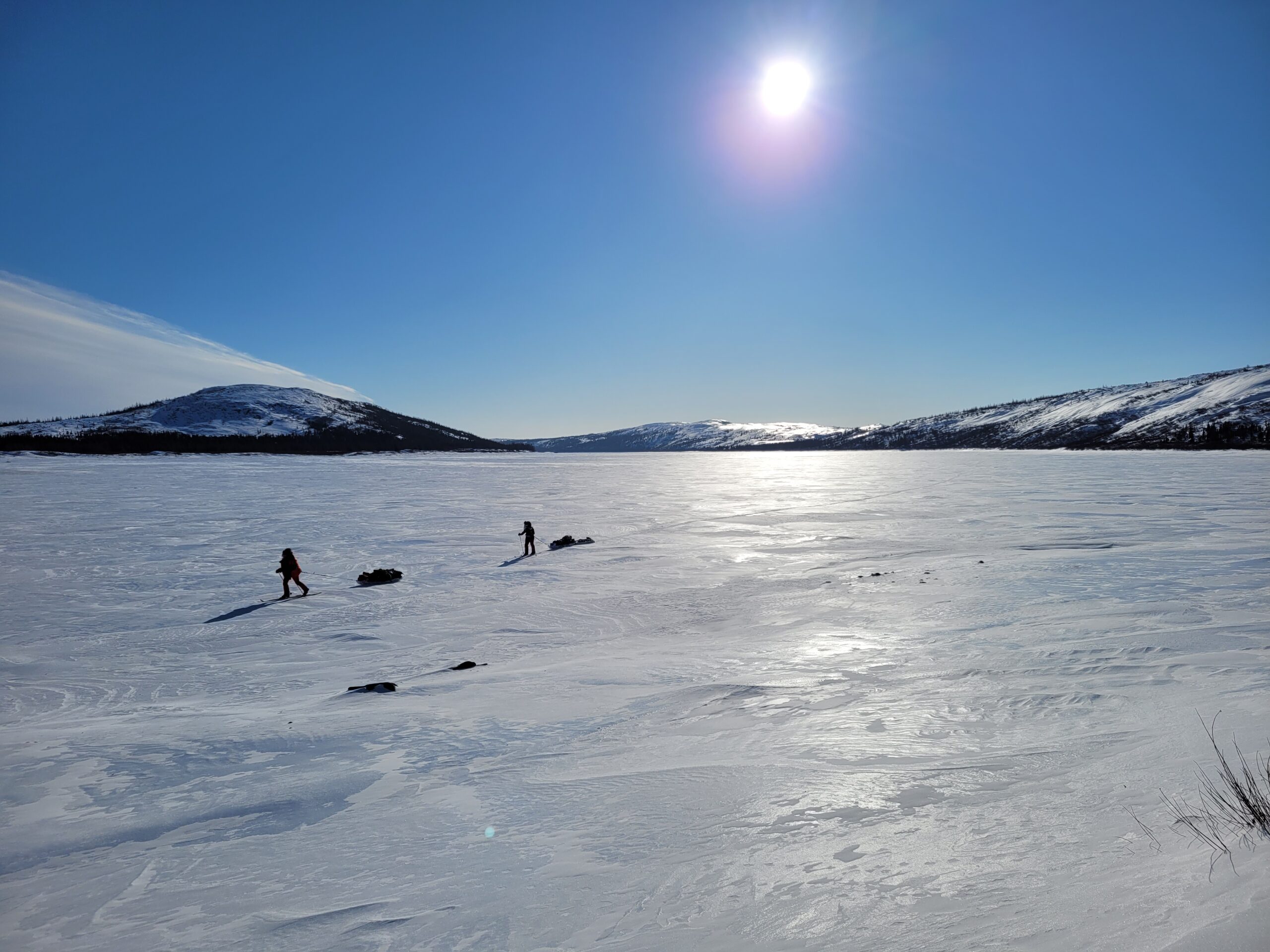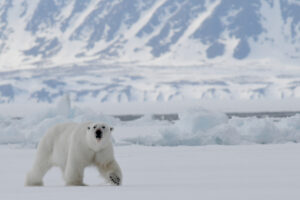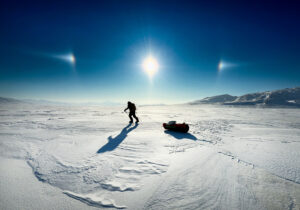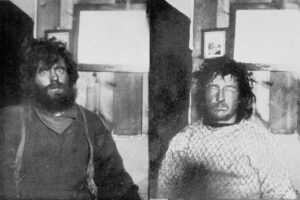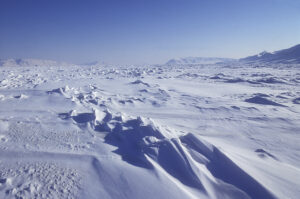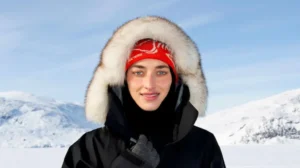After a long weather delay in Resolute, Borge Ousland and Vincent Colliard flew by charter plane yesterday to Ward Hunt Island. From here, they will ski about 60km east over sea ice to Cape Columbia, the northernmost point of Ellesmere Island. This is the starting point of their 1,100km attempt at the first unsupported north-to-south crossing of the island.

Vincent Colliard, left, and Borge Ousland: underway at last. Photo: Ousland/Colliard
Elsewhere, expeditions are ongoing in the Canadian Arctic, while in Greenland, others are just beginning.
Northwest Passage
Spaniards Jose Trejo, Sechu Lopez, and Francisco Mira are 22 days into their sled journey to Gjoa Haven. To avoid open water in Barrow Strait, they chartered a flight from Resolute and began skiing near Prince of Wales Island.
Since April 6, they’ve covered around 260km on skis. After a stormbound period in mid-April forced them to camp for several days, they resumed steady progress. Broken sea ice and snowdrifts have sometimes slowed their pace, but they’ve recently covered 17 to 20km per day.
A few days ago, the trio passed Cape Eyre on Prince of Wales Island and entered Franklin Strait. As of April 26, they were nearing the Tasman Islands, just off the Boothia Peninsula. Yesterday, they reported pleasant temperatures of -15°C to -17°C, light winds, and a welcome improvement in the snow surface.

Broken sea ice has slowed Anders Brenna’s pace. Photo: Anders Brenna
Further south in the Northwest Passage, Norwegian Anders Brenna is about four and a half weeks into what he hoped would be a solo 1,100km sled journey from Gjoa Haven to Glenelg Bay on northern Victoria Island. But difficult snow and sea ice conditions forced him to change course, as his progress was too slow.
Brenna reached the southeastern side of Royal Geographical Society Island and is now heading southwest toward Jenny Lind Island — one of the flattest islands in that very flat part of the Arctic — and ultimately to the town of Cambridge Bay. This will cut his journey significantly short, from 1,100km to just 400km. Even if he had enough food, if Brenna continued on his original course, he couldn’t afford the custom charter flight from Glenelg Bay back to Cambridge Bay. He had hoped to be picked up by snowmobile, which is much cheaper, but soon there will be too little snow for overland snowmobile travel.
Baffin Island
Britons Tom Harding, Ben James, Leanne Dyke, and James Hoyes were dropped off by snowmobile in the Weasel River Valley a few weeks back. From there, they hauled their sleds toward the mountains east of Akshayuk Pass. According to their GPS data, they summited two peaks on April 15 and 17. Afterward, the team skied east.
Northwest Territories
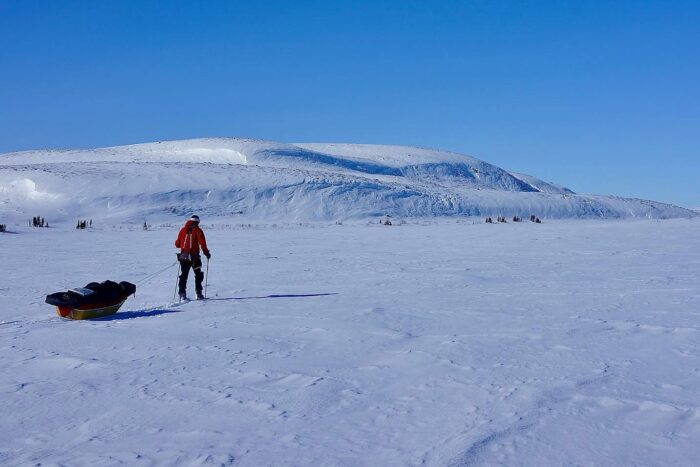
Randulf Valle manhauls on open ground in the Northwest Territories. Photo: Bengt Rotmo
With minimal fuss, Norwegian veterans Bengt Rotmo and Randulf Valle have completed their 700km sled journey from near Yellowknife, Northwest Territories, to Kugluktuk in northwest Nunavut. Departing from Great Slave Lake on March 25, they made good progress north through forest, frozen lakes, and open tundra.
The pair contended with a full range of spring conditions, from rain and crusted snow to whiteouts. Along the way, they encountered wolves, foxes, and caribou. On Easter weekend (April 21-22), they reached Napaktulik Lake, a major landmark. After battling strong headwinds, they used snowmobile tracks to guide them west toward Kugluktuk.
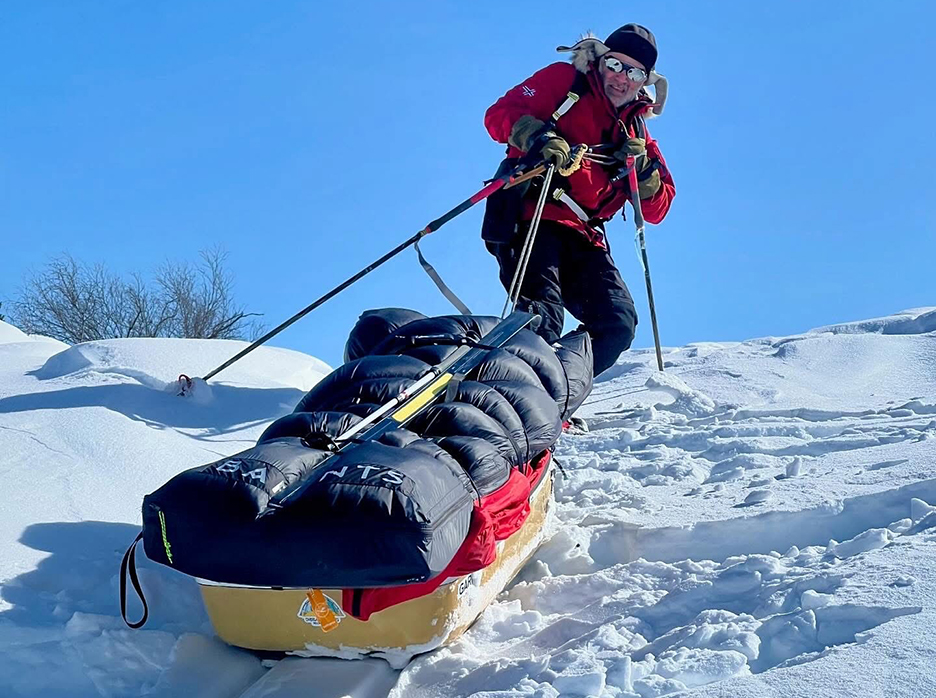
Rotmo hauls up a steep slope. Photo: Bengt Rotmo
Persistent cold temperatures and either sastrugi or fine snow slowed their skiing speed, but by April 23, they had less than 100km to go. In the final days of their month-long journey, the weather improved with calmer winds and better glide. They reached Kugluktuk on April 27.
Ungava Peninsula
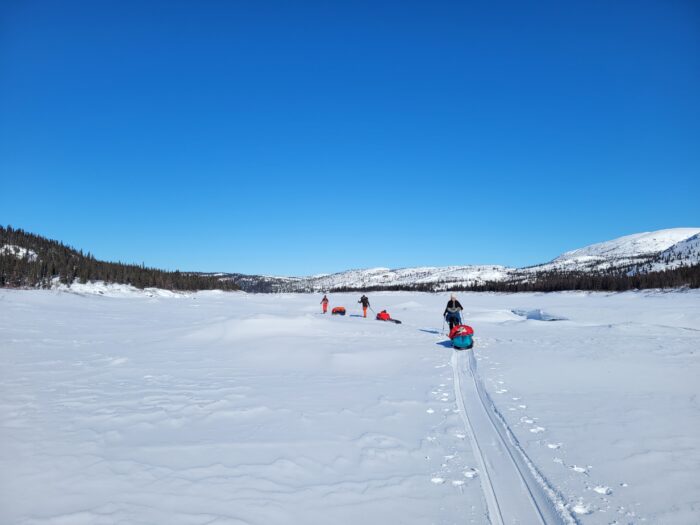
Photo: Roxanne Chenel
We previously reported that two teams have already completed 400km ski crossings from Akulivik to Kangiqsujuaq. Elsewhere, Kathleen Goulet, Chantal Secours, Julie Gauthier, and Roxanne Chenel undertook a 600+km ski expedition from Schefferville to Kangiqsualujjuaq, tracing a traditional canoe route along the De Pas and George River.
The team set off from Iron Arm Bay near Schefferville on February 7 — the coldest time of year — and completed their journey 49 days later. They arrived in Kangiqsualujjuaq on March 27 after covering 614km. Their route followed Attikamagen Lake to the Rivière De Pas, which in turn emptied into the George River. They reported nighttime temperatures as low as -47°C and persistent strong winds.
The cold proved to be both a challenge and an advantage, ensuring solid river ice to Kangiqsualujjuaq. Though they encountered a challenging 15km stretch of jumbled ice blocks from the giant tides near Kangiqsualujjuaq, the solid ice allowed for relatively straightforward travel.
Greenland
There is no update on Japanese Arctic traveler Yasu Ogita, who is due to ski 400km from Siorapaluk, the northernmost village in the world, to the Cape Inglefield region and back. As of April 16, he was in Qaanaq awaiting a helicopter flight to little Siorapaluk.
Further south, polar guide Camilla Ringold leads a team of four on a 2,000km snowkite journey from Kangerlussuaq to Qaanaaq. They were dropped off near Point 660 on April 23 and spent the first few days manhauling through the broken Russell Glacier icefall. During this stretch, Ringold broke through a snow bridge over a crevasse up to her hips but escaped unharmed. After three days, the team reached the inland ice and transitioned to kite-skiing.

Ringold and company in full flow. Photo: Camilla Ringold
Progress then improved sharply, with daily distances reaching up to 100km as they climbed toward their cruising altitude of about 2,300m. In the following days, they adjusted to changing wind conditions, switching between 7m, 11m, and 15m kites. As of yesterday, they have traveled over 200km and are about a day and a half ahead of schedule. However, one of the team has now been evacuated by the Danish Military because of a knee injury after a fall a few days ago.
